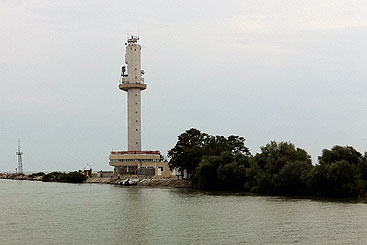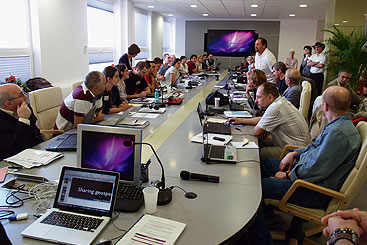Filling the gap between science and policy

Filling the gap between science and policy
An analysis of existing regional observation systems helps strengthen information management systems for the Danube and Black Sea regions and ensures that all stakeholders have access to the vital data they need.

Reaching the Black Sea from the Danube in Sulina, July 2011.
“Without sharing environmental data, science can be difficult, sound decisions can be problematic, and envisioning a sustainable development can be complicated,” says Gregory Giuliani, Work Package Leader for Spatial Data Infrastructure for the enviroGRIDS project.
INsPIRe
The EU directive on Infrastructure for Spatial Information in the European Union (INSPIRE) came into force on 15 May 2007 and will be implemented in various stages, with full implementation required by 2019. The INSPIRE directive aims to create an EU spatial data infrastructure. This will enable the sharing of environmental spatial information among public sector organisations and better facilitate public access to spatial information across Europe.
The Group on Earth Observations is coordinating efforts to build a Global Earth Observation System of Systems (GEOSS), to provide decision-support tools to a wide variety of users. As with the internet, GEOSS will be a global and flexible network of content providers allowing decision makers to access an extraordinary range of information at their desk.
The unique ecosystem of the North-Western Shelf of the Black Sea is burdened by excessive loads of nutrients and hazardous substances from the coastal countries and the rivers that enter it – including the Danube. The enviroGRIDS project aims to improve the information management systems for the Danube and the Black Sea and to build capacity for a highly developed Danube/Black Sea observation and assessment system. Coordinated by the University of Geneva and UNEP, the main aim of the project is to assess water resources in the past, present and future, according to different development scenarios. The enviroGRIDS project will also develop datasets that are compatible with the EU directive on Infrastructure for Spatial Information in the European Union (INSPIRE).
The Black Sea Commission (BSC) and the ICPDR, together with 30 national and international project partners, recently completed a gap analysis of existing regional observation systems. This gap analysis identifies areas where efforts are most needed to reinforce existing observation systems in this region.

The enviroGRIDS workshop ‘Bringing GEOSS Services into Practice’ was held in Bucharest in May 2010.
Gathering data from partners. For the first stage of the analysis, an online questionnaire for gap analysis was developed to get information from project partners, to the best of their knowledge, about available datasets and observation systems at different scales, from local and national to regional and global. In total, information was received about 162 datasets and 30 observations systems covering the Black Sea catchment.
The analysis of the identified datasets and observation systems against the project requirements revealed spatial and temporal gaps in data coverage, gaps in observation systems, and problems with data accessibility, compatibility and interoperability.
Room for improvement. The gap analysis makes recommendations to improve data acquisition networks in each region and country. The recommendations derived from the gap analysis should complement the existing geographical information systems of the ICPDR and BSC.
The analysis pointed to the need to identify national observation systems, services and responsible agencies in all countries of the Black Sea catchment to develop recommendations on filling data gaps at country level. Further, it will be necessary to publish information on available datasets at the enviroGRIDS portal and at the uniform resource management geoportal enviroGRIDS Catalogue, which will be the entry-point to discover data and metadata within enviroGRIDS.
“There is an increasing need for modelling the hydrology of watersheds at high temporal and spatial resolutions,” says Nicolas Ray, enviroGRIDS project manager. “This requires new innovative workflows, and distributed computing – such as Grid computing – is a promising solution for scalable geoprocessing.”
Ensuring compatibility for everyone. The second phase of the analysis focused on analysing the compatibility of the datasets and observation systems with INSPIRE and GEO standards of interoperability, improving the initial analysis and formulating recommendations for improving data acquisition networks in each country and region.
“The large amount of data and information exist at different scales: local, national, regional and global. Increasing the effectiveness of its usage for decisionmakers support is one of the priority tasks, which can’t be achieved without applying interoperability standards for data storage and exchange, such as INSPIRE, GEOSS, OGC,” says Volodymyr Myroshnychenko, enviroGRIDS Project Expert from BSC.
Sharing data freely and openly. Results from this phase of analysis point to the need for the open exchange of data, metadata and products. Shared data, metadata and products should be made available with minimum time delay and with no cost or no more than the cost of reproduction to encouraged research and education. The enviroGRIDS uniform resource management geoportal should be used to register informational services, data or metadata of partner organisations and bring them into the GEOSS framework.
“Filling the gap between science and policy is already technically feasible and will become reality as soon as mental barriers will be removed,” says Anthony Lehmann, enviroGRIDS project initiator and coordinator.
For more information, visit: www.envirogrids.net





